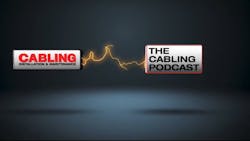The following blog is a transcribed excerpt from Episode 1 of The Cabling Podcast.
By Patrick McLaughlin
Cabling Installation & Maintenance magazine launched in 1993, and at that time there was a head-to-head competitor magazine on the market that focused largely on the business issues of being a cabling contracting organization. When we launched, that other magazine existed and had planted its flag in the industry -- and was successful and was informing its audience and was running great with a focus on business. When CI&M launched, the concept was to focus on those two words that were prominently displayed in the original logo of the magazine: installation and maintenance.
And it was launched with the focus of educating the installer and the technician about the tasks that they needed to do to complete their jobs faster, more efficiently, and to the best ability that could possibly be. Let’s focus on again on the terms “installation” and “maintenance” -- still a part of our name; and all the years we've been in publication, we haven't changed our name. Something did change, though. In the decade that the magazine was launched, in the 1990s, there was sort of a shift in what I’ll call “knowledge level” -- and what I mean by that is that user organizations, the owners of installed cabling systems, by necessity, became more knowledgeable about cabling technology over the course of the 1990s.
(Caveat here: this is my take on things; I think it’s a fairly well-educated take based on what I’ve seen, but others may have other opinions, and I welcome them.)
I think that what happened in that decade was that some of these organizations were committing to a capital expense to install a new cabling system every couple of years. Category 3 was going to be everything they'd ever need. And then Category 5 was going to get you 100 megabits. And then there's this Category 5e, because Gigabit is coming down the pike. So, I think to a large extent, some user organizations found themselves buying a new cabling system every couple of years and said, what's the story with this? Why are we spending all this money so often on cabling systems? What's the deal?
And I think by fiscal necessity, professionals, workers, employees within those user organizations had to learn “what the deal” was with these structured cabling systems. As that happened, our audience mix changed. We launched as the magazine about installation and maintenance -- pulling the stuff, terminating it, making sure it's going to test out to handle the speeds that it needs. My theory is that more and more user organizations have subscribed to the magazine out of necessity, so that they would know what they were dealing with, and would know what they need to specify next time around -- because there would be a next time around.
We of course became cognizant of that. We've always had a tight look at who our audience demographics include, and over the course of the 1990s it was several years in the making, but the number of user organizations subscribing to the magazine eventually just about equaled the number of contracting organizations that were subscribing. But that really didn't immediately provide a wholesale change to the focus of what we were writing about, and what we were reporting on.
I say that because, from the time that the magazine was launched in the early 90s, in addition to focusing on the installation and maintenance tasks, there was always a focus on technology. It wasn't always exclusively about technique. The articles weren't about how to upsell your customer next time to get 20% more revenue on that project. It was about the technologies that were being installed -- what they could support, and that might sort of bode well for the future.
That decade was really a turning point in the magazine, and it's by maintaining a focus on technology that we've been able to speak to that dichotomy of audience. We've been able to speak to the design and installation contractor, and to the user organization, at the same time. Now you add to the mix consultants, who are very much a part of the mix today. Very many user organizations will take on a consultant to handle an upcoming cabling project. So, consultants also became part of our mix.
We believe that one thing that hasn't changed over the course of time is that our focus on the technologies that are being used -- what they can do, and what the future looks like for them -- has been a solid approach that's gotten us to where we are and hopefully has continued to serve the needs of our audience.
So we're closing in on the end of 2021 here, and for me to tell a story about the 1990s might seem out of place, but I really think that was a real inflection point, even though it was decades ago, in the history of the publication. And the continued commitment that we've had to serve the needs of contracting organizations, user organizations, and consultants – and then you throw in the mix a bit from service provider organizations who also make up a segment of our audience -- has kept us on our toes.
And I like to think that we've kept that universe of folks informed over the course of these decades, and have allowed them to do their jobs, maybe a little bit better by what they've learned from us.
